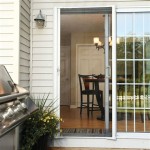How To Fit Patio Door Lock
Enhancing home security frequently involves upgrading or replacing existing locks, and patio doors, often overlooked, are a crucial entry point to consider. Properly fitted patio door locks can significantly deter potential intruders. This article provides a comprehensive guide on how to fit a patio door lock, covering various types of locks, necessary tools, and detailed installation procedures.
Before commencing the installation process, it is imperative to identify the type of patio door lock currently in place, or the type being installed. Different types of patio door locks necessitate varying installation techniques. Common types include surface-mounted locks, mortise locks, and sliding bolt locks.
Surface-mounted locks are fitted directly onto the surface of the door and frame. They are relatively easy to install and are suitable for doors where mortising (cutting a recess) is not desired. Mortise locks, on the other hand, require a recess to be cut into the door’s edge. They generally offer a higher level of security due to their robust construction and are more resistant to forced entry. Sliding bolt locks are a supplementary security measure that involves a bolt sliding into a receiving plate on the door frame.
The selection of the appropriate patio door lock should be based on factors such as the existing door frame structure, the desired level of security, and personal preference. Considerations should be given to the ease of operation and the visual aesthetics of the lock.
Preparing for Installation: Tools and Materials
Prior to initiating the installation, gathering the necessary tools and materials is essential for a smooth and efficient process. The specific tools required may vary depending on the type of lock being installed, but a general list includes:
• Screwdriver (Phillips and flathead)
• Drill with various drill bits (including wood and metal bits)
• Measuring tape
• Pencil
• Safety glasses
• Work gloves
• Chisel (for mortise locks)
• Hammer (for mortise locks)
• Level
• Lock installation kit (if available)
• New patio door lock with all its components (strike plate, screws, keys, etc.)
Ensuring all necessary components are readily available will minimize interruptions during the installation process. Furthermore, safety glasses and work gloves are crucial for protecting eyes and hands from potential hazards.
Installing a Surface-Mounted Patio Door Lock
Surface-mounted patio door locks are generally considered the easiest to install. The following steps outline the installation procedure:
1.
Positioning the Lock:
Determine the desired location for the lock on the door. Typically, it is placed at a comfortable height for operation. Use a measuring tape and pencil to mark the position accurately.2.
Marking Pilot Holes:
Hold the lock body against the door and mark the locations for the screw holes. Ensure the lock is aligned correctly with the edge of the door.3.
Drilling Pilot Holes:
Using a drill with a drill bit slightly smaller than the screws provided with the lock, drill pilot holes at the marked locations. This prevents the wood from splitting when the screws are inserted.4.
Attaching the Lock Body:
Align the lock body with the pilot holes and secure it to the door using the provided screws. Tighten the screws firmly, but avoid over-tightening, which could strip the screw threads.5.
Positioning the Strike Plate:
Close the patio door and determine the corresponding location for the strike plate on the door frame. Mark this position accurately.6.
Marking and Drilling Strike Plate Holes:
Hold the strike plate against the door frame and mark the locations for the screw holes. Drill pilot holes at these locations, similar to the lock body installation.7.
Attaching the Strike Plate:
Align the strike plate with the pilot holes and secure it to the door frame using the provided screws. Again, ensure the screws are tightened firmly but not over-tightened.8.
Testing the Lock:
Test the lock to ensure it functions smoothly and securely. The bolt should engage fully into the strike plate without any binding or resistance. If necessary, adjust the position of the strike plate slightly to ensure proper alignment.Installing a Mortise Patio Door Lock
Installing a mortise lock is a more complex procedure that requires cutting a recess into the door’s edge. Consider seeking professional assistance if unfamiliar with this type of installation.
1.
Marking the Mortise:
Place the mortise lock body against the edge of the door and trace its outline onto the door’s edge. This outline will serve as a guide for cutting the mortise.2.
Drilling the Mortise:
Using a drill with a large drill bit, drill a series of overlapping holes within the marked outline. This will remove the bulk of the wood from the mortise.3.
Chiseling the Mortise:
Use a chisel and hammer to carefully remove the remaining wood from the mortise, creating a clean and rectangular recess. Ensure the mortise is deep enough to accommodate the lock body completely.4.
Fitting the Lock Body:
Insert the lock body into the mortise. It should fit snugly and securely. If necessary, refine the mortise with the chisel to ensure a proper fit.5.
Securing the Lock Body:
Use screws to secure the lock body to the door. The screws will typically pass through the lock body and into the door frame.6.
Installing the Faceplate:
The faceplate covers the edge of the mortise and provides a finished look. Position the faceplate over the mortise and secure it with screws.7.
Positioning the Strike Plate:
Close the patio door and determine the corresponding location for the strike plate on the door frame. Mark this position accurately.8.
Marking and Chiseling the Strike Plate Recess:
Trace the outline of the strike plate onto the door frame. Use a chisel to create a shallow recess for the strike plate to sit flush with the frame.9.
Attaching the Strike Plate:
Align the strike plate with the recess and secure it to the door frame using screws.10.
Testing the Lock:
Test the lock to ensure it functions smoothly and securely. The bolt should engage fully into the strike plate without any binding or resistance. Adjust the position of the strike plate or faceplate if necessary to ensure proper alignment.The installation of a mortise lock requires precision and patience. It is crucial to ensure the mortise is cut accurately and the lock body is fitted securely.
Installing a Sliding Bolt Patio Door Lock
Sliding bolt locks are a basic yet effective way to add extra security to patio doors. Their installation is relatively straightforward.
1.
Positioning the Bolt Lock:
Determine the preferred location for the bolt lock on the inside of the sliding door. Common placement is near the top or bottom of the door for added strength.2.
Marking Screw Holes for the Lock Body:
Hold the bolt lock body against the door and mark the positions for the screw holes. Utilize a level to ensure the lock is mounted vertically or horizontally, depending on the orientation desired.3.
Drilling Pilot Holes:
Drill pilot holes at the marked locations using a drill bit slightly smaller than the screws provided with the lock. This helps prevent the wood from splitting.4.
Attaching the Lock Body:
Align the lock body with the pilot holes and secure it to the door using the provided screws. Tighten the screws firmly, but avoid over-tightening.5.
Positioning the Strike Plate:
Close the patio door and slide the bolt into the locked position to determine the exact location for the strike plate on the stationary door frame.6.
Marking Screw Holes for the Strike Plate:
Mark the positions for the screw holes on the door frame. Ensure the strike plate aligns perfectly with the bolt when the door is closed.7.
Drilling Pilot Holes for the Strike Plate:
Drill pilot holes at the marked locations on the door frame, again using a drill bit slightly smaller than the screws.8.
Attaching the Strike Plate:
Align the strike plate with the pilot holes and secure it to the door frame using the provided screws. Ensure the strike plate is securely fastened to withstand the force of the bolt.9.
Testing the Lock:
Test the bolt lock by sliding the bolt into the locked and unlocked positions. Ensure the bolt moves smoothly and engages fully into the strike plate without any resistance.10.
Adjustments:
If the bolt does not align correctly with the strike plate, slightly adjust the position of the strike plate by loosening the screws and repositioning it until proper alignment is achieved. Retighten the screws once aligned.Following these steps will effectively install a sliding bolt patio door lock, providing an additional layer of security against forced entry.
Regardless of the type of patio door lock installed, regular maintenance is crucial to ensure its continued functionality and security. This includes lubricating the lock mechanism periodically, inspecting the screws for tightness, and checking for any signs of damage or wear. Addressing any issues promptly will help to extend the lifespan of the lock and maintain the security of the home.

How To Replace Sliding Door Lock Handle Easy Simple Latch

How To Replace A Sliding Glass Door Latch Patio Replacement Won T Lock

How To Replace Sliding Patio Door Lock Remove And Install Youtube

How To Install A Key Lock On Patio Door 1080p

Installing A Defender Security Patio Sliding Door Loop Lock Sgd R35 71x80 Youtube

Sliding Patio Door Handles Replacing Surface Mount

Installing The Exterior Keyed Lock On Frenchwood Gliding Doors Andersen Windows

How To Replace Patio Door Lock A Step By Guide Window Hardware Direct

How To Install A Secure Sliding Patio Door Lock

Sliding Patio Door Lock Q A








